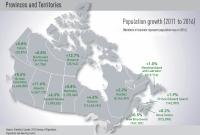Support strong Canadian climate journalism for 2025
Superheated housing market notwithstanding, 81-year-old Ashley Anthony says he has no plans to give up the detached three-bedroom suburban house he has lived in for the past 43 years.
His three kids have long since moved out, but this corner of Brampton, Ont., northwest of Toronto, is still home for Anthony and his 77-year-old wife Gladys.
"Most of the people here are retired. It's very quiet. There's no noise and confusion here," he reasons. "We know everybody here, we're comfortable, so why should we move?"
Anthony is far from alone. Canada's suburbs — the bedroom communities, towns and cities that surround major urban centres like Toronto, Montreal and Vancouver — are going grey far more quickly than their hustle-and-bustle counterparts, the latest census numbers show.
While Toronto itself saw the number of residents aged 65 and older grow by just 13.1 per cent between 2011 and 2016, Brampton's share of seniors increased by nearly 40 per cent during the same time frame, Statistics Canada reported Wednesday.
Not far away in neighbouring Whitby, the increase was 31.3 per cent. And in Vaughan, the ranks of those aged 85 and older grew by 53 per cent — more than twice the increase among the same age cohort in the big city.
Once comprising mostly sleepy villages or towns, suburbia underwent a massive transformation in the 1970s and 1980s. Urban sprawl took root. Affordable houses and sprawling backyards lured younger families like the Anthonys — and many never moved out.
"My neighbour on the side, he says: 'I'm going to stay in this house 'til I die. I'm not moving,'" Anthony says with a chuckle.
As a result, when children move on and leave parents behind or elderly spouses die, suburban households become increasingly empty nests.
"The suburbs now have a much older population than they used to," says Doug Norris, chief demographer at Environics Analytics in Ottawa. "The suburbs look a lot more like the city now."
For planners and policymakers, it's a pressing problem. Canada has an aging population as the baby boomers reach retirement age, but the public transit, services and retail options of the larger cities make them easier to navigate for the less mobile.
Accessing services and amenities like grocery stores or health care in lower-density subdivisions, on the other hand, usually requires getting into a car and driving.
Car dependency, as planners call it, has become an unrelenting thing. Ontario government figures suggest that about 42 per cent of people in car-dependent suburbs around Toronto won't have a driver's licence by 2036 — either because they are no longer fit to drive or want to avoid the cost and stress of vehicle ownership.
Glenn Miller, senior associate with the Canadian Urban Institute, says there's a growing risk that many people will find themselves stuck in the suburbs because they no longer drive.
"That puts a stark problem before us," says Miller, author of a recent paper on the phenomenon called "No Place To Grow Old."
"From a societal point of view, if you have a very large number of people who become isolated and can't access the things they need to on a daily basis, we can't solve the problem by building more long-term care beds."
That means the challenge for planners and policy-makers is to find ways to move services closer to where the people are, rather than to force the people to relocate. The problem, observers say, is that few places have actually taken steps to make their land-use plans more "age-friendly."
Dan Leeming, an urban planner with the Planning Partnership in Toronto, does cite a shift in thinking when it comes to new housing developments.
Leeming tries to start with three basic questions: Where can I walk to in two minutes? In five minutes? In 10 minutes? People, he says, should be able to walk to a parkette in two minutes, and the bus stop in five — what he calls the building blocks of sustainability and community livability.
One place that appears to be setting a forward-looking example is Markham, Ont., north of Toronto. Once more typical of suburban sprawl, Markham has been increasing its housing diversity — more townhouses and stacked housing — rather than endless rows of detached bungalows and double-storey homes.
"You're starting to get high density in suburban communities that really wasn't there five or eight years ago," Leeming says. "With density, you can now begin to support transit. (But) it's going to take years for transit to get caught up."
Anthony, for his part, is well aware of what's in store. For now, at least, he's not worried.
He has a pastoral 15-minute walk to Brampton's city centre. When mobility does become an issue, he's hoping the kids can help out with grocery shopping or medical appointments. In a pinch, he says, there's the option many others don't have: a short cab drive to the supermarket.
"At the moment, we are very comfortable," he says. "But who knows?"





Comments